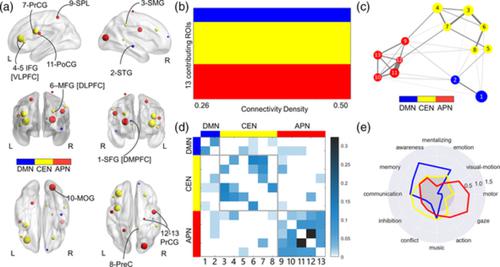当前位置:
X-MOL 学术
›
Hum. Brain Mapp.
›
论文详情
Our official English website, www.x-mol.net, welcomes your feedback! (Note: you will need to create a separate account there.)
Prediction of trust propensity from intrinsic brain morphology and functional connectome
Human Brain Mapping ( IF 4.8 ) Pub Date : 2020-10-01 , DOI: 10.1002/hbm.25215 Chunliang Feng 1, 2 , Zhiyuan Zhu 3, 4 , Zaixu Cui 5 , Vadim Ushakov 6, 7 , Jean-Claude Dreher 8 , Wenbo Luo 9 , Ruolei Gu 10, 11 , Xia Wu 3, 4 , Frank Krueger 12, 13
Human Brain Mapping ( IF 4.8 ) Pub Date : 2020-10-01 , DOI: 10.1002/hbm.25215 Chunliang Feng 1, 2 , Zhiyuan Zhu 3, 4 , Zaixu Cui 5 , Vadim Ushakov 6, 7 , Jean-Claude Dreher 8 , Wenbo Luo 9 , Ruolei Gu 10, 11 , Xia Wu 3, 4 , Frank Krueger 12, 13
Affiliation

|
Trust forms the basis of virtually all interpersonal relationships. Although significant individual differences characterize trust, the driving neuropsychological signatures behind its heterogeneity remain obscure. Here, we applied a prediction framework in two independent samples of healthy participants to examine the relationship between trust propensity and multimodal brain measures. Our multivariate prediction analyses revealed that trust propensity was predicted by gray matter volume and node strength across multiple regions. The gray matter volume of identified regions further enabled the classification of individuals from an independent sample with the propensity to trust or distrust. Our modular and functional decoding analyses showed that the contributing regions were part of three large‐scale networks implicated in calculus‐based trust strategy, cost–benefit calculation, and trustworthiness inference. These findings do not only deepen our neuropsychological understanding of individual differences in trust propensity, but also provide potential biomarkers in predicting trust impairment in neuropsychiatric disorders.
中文翻译:

从内在大脑形态和功能连接组预测信任倾向
信任构成了几乎所有人际关系的基础。尽管显着的个体差异是信任的特征,但其异质性背后的驱动神经心理学特征仍然模糊不清。在这里,我们在健康参与者的两个独立样本中应用了预测框架,以检查信任倾向与多模态大脑测量之间的关系。我们的多变量预测分析表明,信任倾向是通过多个区域的灰质体积和节点强度来预测的。已识别区域的灰质体积进一步使从具有信任或不信任倾向的独立样本中的个体分类成为可能。我们的模块化和功能解码分析表明,贡献区域是涉及基于微积分的信任策略、成本收益计算和可信度推理的三个大型网络的一部分。这些发现不仅加深了我们对信任倾向个体差异的神经心理学理解,而且还为预测神经精神疾病的信任损害提供了潜在的生物标志物。
更新日期:2020-12-08
中文翻译:

从内在大脑形态和功能连接组预测信任倾向
信任构成了几乎所有人际关系的基础。尽管显着的个体差异是信任的特征,但其异质性背后的驱动神经心理学特征仍然模糊不清。在这里,我们在健康参与者的两个独立样本中应用了预测框架,以检查信任倾向与多模态大脑测量之间的关系。我们的多变量预测分析表明,信任倾向是通过多个区域的灰质体积和节点强度来预测的。已识别区域的灰质体积进一步使从具有信任或不信任倾向的独立样本中的个体分类成为可能。我们的模块化和功能解码分析表明,贡献区域是涉及基于微积分的信任策略、成本收益计算和可信度推理的三个大型网络的一部分。这些发现不仅加深了我们对信任倾向个体差异的神经心理学理解,而且还为预测神经精神疾病的信任损害提供了潜在的生物标志物。



























 京公网安备 11010802027423号
京公网安备 11010802027423号